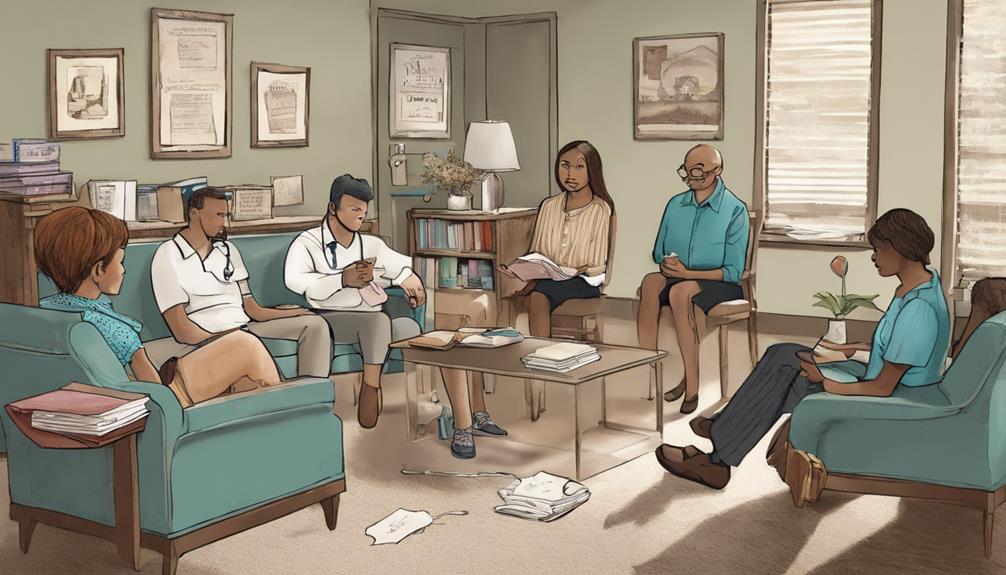So, you've found yourself in the less-than-ideal situation of a narcissist partner cheating on you. It's a scenario that can leave one feeling bewildered, hurt, and questioning everything.
What do you do next? Well, let's unpack the complexities of maneuvering this challenging terrain with a partner who may not play by the rules of emotional honesty and accountability.
Key Takeaways
- Maintain emotional control and confront the narcissist calmly.
- Establish clear boundaries and communicate consequences for crossing them.
- Seek emotional validation and rebuild self-esteem through support and counseling.
- Focus on self-care, therapy, and setting boundaries to heal and move forward after betrayal.
Signs of Narcissist Cheating Behavior
Recognizing signs of narcissist cheating behavior can be essential in safeguarding oneself and making well-informed decisions within the relationship. When suspecting that a partner is cheating, there are specific signs to look out for, especially when dealing with someone who exhibits narcissistic traits.
One common indicator is frequent lying and secretive behavior. Narcissists who cheat often go to great lengths to hide their infidelity, leading to inconsistencies in their stories and unexplained absences.
Sudden changes in personality, increased aggression, and irritability can also signal potential cheating behavior in narcissists. These individuals may resort to manipulative tactics to cover up their actions, making it challenging to uncover the truth.
Confronting the Narcissist About Cheating

If you suspect that your partner, exhibiting signs of narcissistic behavior, may be cheating, it's important to approach the confrontation calmly and assertively to address the issue. When preparing to confront your partner about cheating, follow these steps:
- Maintain Emotional Control: Stay calm and collected to guarantee the situation from escalating.
- Use 'I' Statements: Express your feelings using statements like 'I feel hurt' to avoid blaming and escalating conflicts.
- Set Clear Boundaries: Communicate what behaviors are unacceptable in the relationship to establish clear expectations.
- Be Direct and Straightforward: Convey your message clearly and effectively to warrant your partner understands the seriousness of the situation.
Confronting your partner about cheating can be challenging, but by remaining composed and assertive, you can address the issue with clarity and respect. Remember to prioritize your emotional well-being and set boundaries to protect yourself during this difficult time.
Establishing Boundaries After Infidelity

Establishing clear boundaries after infidelity is essential to protect our emotional and mental well-being. It's vital to communicate boundaries assertively and consistently, ensuring that our self-respect and integrity remain intact.
By setting consequences for crossing these boundaries, we enforce accountability and send a clear message that cheating isn't acceptable. Prioritizing self-care during this challenging time is paramount for our mental health.
Seeking support from trusted friends or professionals can provide valuable guidance as we navigate the aftermath of infidelity. Additionally, it's important to reevaluate the relationship and carefully consider whether rebuilding trust is possible while honoring our boundaries.
Seeking Support and Counseling

Seeking support from trusted individuals or professionals is a crucial step in managing the complexities of dealing with a cheating narcissist partner. When faced with such a challenging situation, it's important to remember that you aren't alone. Here's how seeking support and counseling can help:
- Emotional Validation: Talking to friends, family, or a therapist can provide validation for your feelings of betrayal and hurt.
- Rebuilding Self-Esteem: Counseling sessions can assist in rebuilding your self-esteem that may have been damaged by the infidelity.
- Setting Boundaries: Professional counseling can help you set healthy boundaries in your relationship with a narcissist and establish clear expectations.
- Understanding Relationship Dynamics: Counseling can guide you in identifying red flags, developing coping strategies, and understanding how to manage the complexities of being with a cheating narcissist.
Moving Forward and Healing After Betrayal

Focusing on self-care and healing is vital in rebuilding trust in ourselves after experiencing betrayal from a cheating narcissist partner. Seeking therapy or counseling can provide a safe space to process the complex emotions stemming from the betrayal and gain a fresh perspective on the situation. It's essential to surround ourselves with supportive friends and family members who understand the challenges we're facing.
Setting boundaries is a key aspect of protecting ourselves from further emotional harm and manipulation. By clearly defining what's and isn't acceptable in our relationships, we can regain a sense of control and agency. Engaging in activities that promote self-discovery and personal growth can also be empowering.
This journey of healing is about rediscovering our worth, understanding our strengths, and learning from the experience. Remember, healing takes time, but with patience, self-compassion, and the right support, it's possible to move forward positively from the emotional scars left by a cheating narcissist partner.
Conclusion
As we navigate the aftermath of betrayal by a cheating narcissist, it's vital to remember that healing is a journey, not a destination. Let's embrace the Phoenix rising from the ashes, symbolizing our resilience and strength in overcoming adversity.
By seeking support, setting boundaries, and focusing on our own growth and well-being, we can emerge from this experience stronger and more empowered than ever before. Remember, we're the architects of our own transformation.









